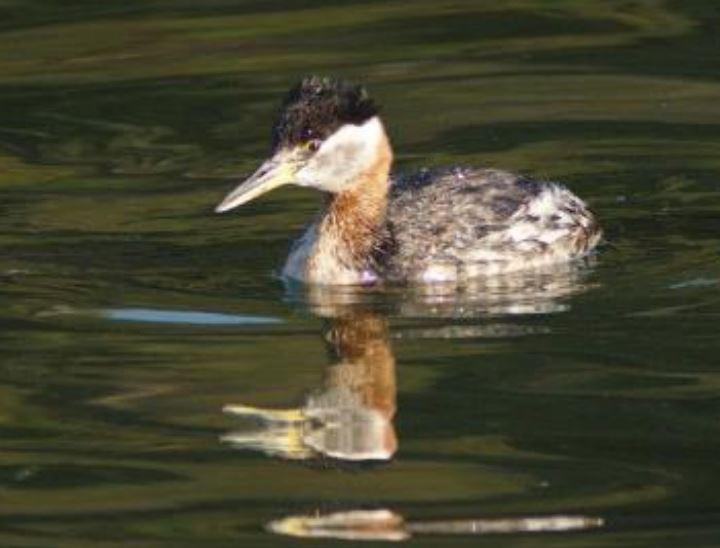Moderate
In Washington, the population size and trend of the red-necked grebe is unknown. Status of this species is not clear. Wintering populations in the state exhibit ecological traits identified as risk factors for marine birds that occur in the Salish Sea.
Description and Range
Physical description
Red-necked grebes are about 20 inches in length. They have a long neck, are gray-brown above, and have a dusky-white underside. They have dusky-white cheek patches, and a black cap that extends over the eyes. Non-breeding and immature birds have a dusky-white throat whereas breeding adults have a rusty-orange neck, hence the name “red-necked.”
Ecology and life history
Red-necked grebes nest on freshwater lakes, reservoirs and sloughs where marsh vegetation is present and overwinter in marine bays, estuaries and protected shorelines. By May, they have usually arrived at their breeding sites where they remain until fall.
Nesting occurs on shallow, freshwater lakes, as well as shallow protected marsh areas and secluded bays of larger lakes. Nest sites are selected based on a combination of attributes including shelter from wind and waves, availability of nest materials and anchorage, easy swimming access, proximity to open water, and distance from terrestrial predators. Breeding pairs typically nest solitarily and both members of the pair incubate one brood per year. Nests are constructed in reeds along lake margins and are raised slightly above the surface of the water
By mid-November, most have returned to their wintering areas. Winter habitats include saltwater bays and estuaries and other protected locations. In migration, they are found on lakes, ponds, and rivers.
Red-necked grebes dive for their prey and feed on fish and insects, as well as crustaceans, mollusks, amphibian eggs and larvae, and some vegetation.
Geographic range
The red-necked grebe overwinters along the Pacific coast from Alaska to southern California. In western Washington, it is a fairly common migrant and winter visitor; it rarely occurs in summer in marine waters and on freshwater lakes west of the Cascades. East of the Cascades, the red-necked grebe is a local, fairly common breeder in northeastern Washington, but is a rare to uncommon winter visitor. The size of Washington’s breeding population is unknown.
For a maps of range-wide distribution and other species' information, check out NatureServe Explorer and the International Union of Conservation of Nature.
Climate vulnerability
Sensitivity to climate change
Moderate-
High
Very limited information, but likely affected by changes in nesting and roosting habitat and prey availability. Sea level rise and coastal erosion could lead to declines in protected winter habitat. Increased storminess or wind may enhance vulnerability of nests. Additionally, juveniles feed mainly on invertebrates (e.g., crustaceans, mollusks); thus, any declines in these populations due to ocean acidification could limit prey availability for juvenile red-necked grebes.
Exposure to climate change
Moderate
- Sea level rise
- Increased storminess
- Declines in pH
Conservation
Conservation Threats and Actions Needed
- Resource information collection needs
- Threat: Determine population trend for both winter and breeding populations.
- Action Needed: Conduct surveys to understand species trend and distribution.
See the Climate vulnerability section for information about the threats posed by climate change to this species.
Resources
References
Stout, B. E., and G. L Nuechterlein. 1999. Red-necked Grebe (Podiceps grisegena). Birds of North America 465: 1- 32.
Vischis, L. I., C. K. Johnson, J. R. Evenson, S. F. Pearson, K. L. Barry, P. D. Davidson, M. G. Raphael and J. K. Gaydos. 2014. Assessing ecological correlates of marine bird declines to inform marine conservation. Conservation Biology: doi: 10.1111/cobi.12378.
Wahl , T. R. 2005. Red-necked grebe (Podiceps grisegena). Pp 79 – 80 in T. R. Wahl, B. Tweit, and S. G. Mlodinow (eds.) Birds of Washington: Status and Distribution. Oregon State University Press, Corvallis, OR, USA. 436 pp.


